For non-Omicron Covid news (and some additional Omicron news) this week, see the weekly post, the post on testing, and the post on the CDC nowcast.
First off, best possible personal news: Me and my family are feeling much better. The illness has passed. The rapid tests we did all came back negative, so it’s not quite best possible news of getting super mild infections and recovering, but I will very much take it. Thank you to everyone who sent their well-wishes, and to everyone who is sick now, I wish a speedy recovery to you as well.
Now, back to the rest of the Omicron wave.
There are three major fronts. There’s the question of what is happening and how many cases we have, there’s the question of how people are reacting and will react to it, and there’s the question of severity.
On the case front, it looked like the UK might have peaked, which would be big, but it now looks like that was premature. Still, that this could even look like it might have happened is a big piece of the puzzle. My best guess is that the generation time of Omicron is lower than we thought, which means R0 is lower, which means that it’s easier (but still hard, and long term still probably not feasible or advisable) to take enough action to slow it down.
On the severity front, we have a lot more data. As far as I can tell, it mostly tells a consistent story of modestly reduced severity for infection in a given individual (after controlling for everything) in the 30%-60% range, which will help a lot but is no match for exponential growth. I’d love to be conclusive, but it’s all super complex and convoluted. That’s what the bulk of this post is about.
On the reaction front, there have been a lot of extreme reactions to the Omicron situation, by individuals. I’m hearing and noticing a lot of folks deciding to lock it down for themselves. Many of them are doing so in order to ensure they can still have their family Christmas, which seems like an excellent reason even if one is not personally worried.
Reactions
The reaction has been so big that things looked like they might have halted or turned around somehow in the United Kingdom, although that’s looking less likely now. More on that in the UK section.
Individuals reacting is great, because they make much better judgment calls about what’s worthwhile and not worthwhile than broad regulatory rules, and also because of that other problem.

Where I disagree with Nate is that I don’t think the lack of credibility is a problem. I think it is a solution to the fact that the policymakers are not credible. If something isn’t credible, it’s good for us to treat it that way.
In perhaps related news, Mr. President, if you’re not simply lying, please please please have your people call me.

Best Possible News?
This is from a generally excellent overview thread from Bob Watcher. His frame is a fitting one, good news and bad news, with lots of both.
The tricky part is knowing what is good news, and what is bad news. So you think you can tell? It all depends on all the other news. Blowing through in six weeks could be a crisis and a disaster, or it could be mostly harmless and the way we wake up to a new birth of freedom. Missing a lot of cases could mean we’re about to get clobbered, or it could mean things are mostly harmless. And so on.
Plus what is good and bad news depends on what you already know, and thus what remains fixed. There’s always another level.
And thus, in an excellent thread, I found confirmation of what is maybe the best possible news, labeled quite reasonably as bad news, which I’d missed until now (paper, from Norway), and here a case study is plenty of information.

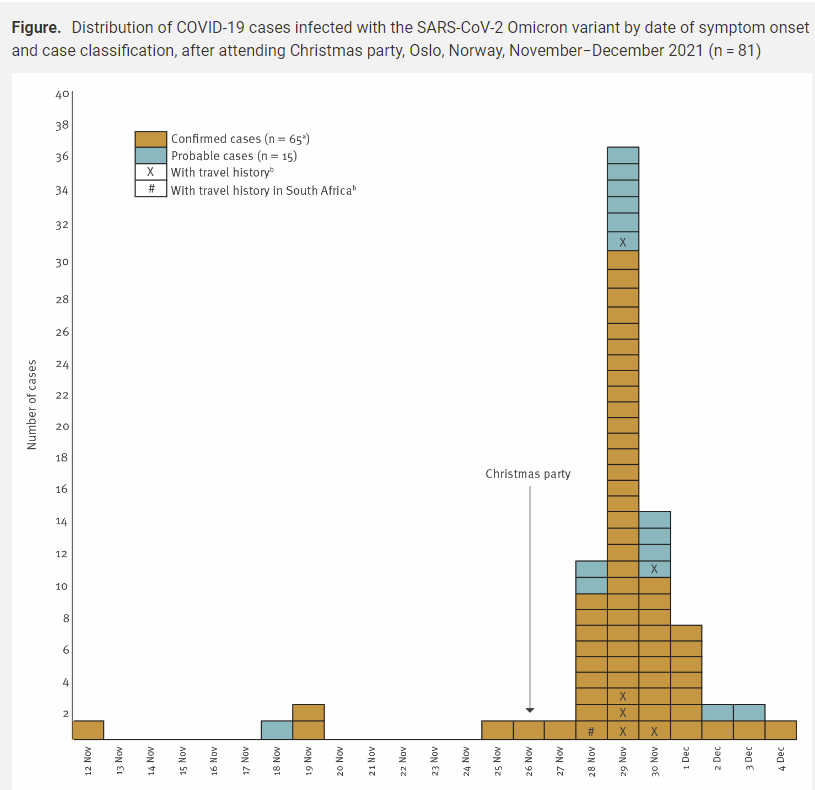
This is potentially the best possible news because of the interaction between R0 and generation time.
We know that Omicron was doubling every two days around the world. Then suddenly maybe it wasn’t.
But if symptom onset comes in three days, and you’re infectious in two, then doubling every two days is perhaps only once per generation. This also matches observations about rapid tests from Mina. There’s a chance we have to do is cut it down by half from here. And that, my friends, is within our powers. A little extra vaccination, a little more caution for a bit, a lot more asymptomatic cases, and the wave is over without overwhelming the hospitals. Huge if true.
Wait. It’s within our powers? Oh, no, maybe? Will we try and shut down everything for months on end for a virus that totally doesn’t justify it?
Or maybe that’s good, because if the choice continues to be left to the public, we’ll mostly make good decisions at this point, and it will be fine again?
It can be really hard to tell heaven from hell.
South Africa
What happened in South Africa, if this was the peak, was remarkable. They got away (mostly) clean. It certainly is suggestive of reduced severity, demographic differences can only go so far.

So far, so good, and it’s getting to be far enough along that this means something.
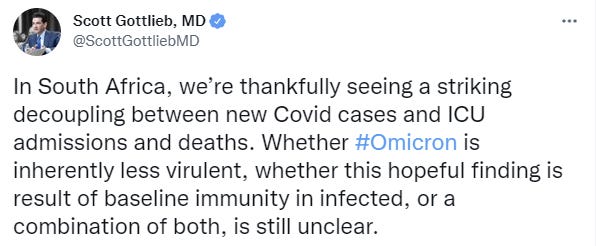
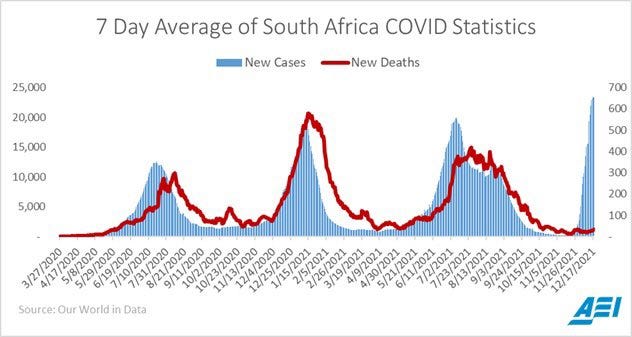
This requires analysis. There’s a new paper out of South Africa claiming Omicron is less severe. Let’s check it out. Their method was to take the whole of South Africa’s hospital system for Maximum Data, so let’s see what they got.
Results
From 1 October through 6 December 2021, 161,328 COVID-19 cases were reported nationally; 38,282 were tested using TaqPath PCR and 29,721 SGTF infections were identified. The proportion of SGTF infections increased from 3% in early October (week 39) to 98% in early December (week 48). On multivariable analysis, after controlling for factors associated with hospitalisation, individuals with SGTF infection had lower odds of being admitted to hospital compared to non-SGTF infections (adjusted odds ratio (aOR) 0.2, 95% confidence interval (CI) 0.1-0.3).
Among hospitalised individuals, after controlling for factors associated with severe disease, the odds of severe disease did not differ between SGTF-infected individuals compared to non-SGTF individuals diagnosed during the same time period (aOR 0.7, 95% CI 0.3-1.4). Compared to earlier Delta infections, after controlling for factors associated with severe disease, SGTF-infected individuals had a lower odds of severe disease (aOR 0.3, 95% CI 0.2-0.5).
Conclusion
Early analyses suggest a reduced risk of hospitalisation among SGTF-infected individuals when compared to non-SGTF infected individuals in the same time period. Once hospitalised, risk of severe disease was similar for SGTF- and non-SGTF infected individuals, while SGTF-infected individuals had a reduced risk of severe disease when compared to earlier Delta-infected individuals. Some of this reducton is likely a result of high population immunity.
So far, so promising, but what did we control for?
We controlled for factors known to be associated with hospitalisation (age, sex, presence of co-morbidity, province and healthcare sector) and adjusted for known prior SARS-CoV-2 infection.
…
We controlled for factors known to be associated with severity (age, presence of comorbidity, sex, province and healthcare sector) and adjusted for the number of days between the date of specimen collection and date of hospital admission, known prior SARS-CoV-2 infection and SARS-CoV-2 vaccination status.
The baseline numbers are certainly impressive.
Among individuals with SGTF infection diagnosed between 1 October – 30 November 2021, 2.5% (261/10,547) were admitted to hospital, compared to 12.8% (121/948) of individuals with non-SGTF infection (P<0.001).
Remember, when the United Kingdom had a study everyone was citing that did similar adjustments, it was based off of 24 Omicron hospitalizations (!) and thus headlines were written. This is rather bigger.
As always, though, it’s not that simple.
Our findings correlate with DATCOV surveillance hospitalisation data showing that, among patients who had a known hospital outcome, 32% of COVID-19 admissions during the early fourth wave were severe compared to 65% during the early third wave.
By November 2021, a high proportion of the South African population had some level of SARS-CoV-2 immunity, as a result of previous natural infection and/or vaccination. It is estimated that after the third SARS-CoV-2 wave 60%-70% of individuals in South Africa had evidence of previous SARS-CoV-2 infection.
By 9 December 2021, 65% of individuals aged ≥60 years, 61% aged 50-59 years, 48% aged 35-49 and 29% aged 18-34 years had received ≥1 dose of SARS-CoV-2 vaccine, and 58% of individuals aged ≥60 years, 55% aged 50-59 years, 43% aged 35-49 and 24% aged 18-34 years were fully vaccinated against SARS-CoV-2 (one dose of Johnson & Johnson or two doses of Pfizer-BioNTech).
It is difficult to disentangle the relative contribution of high levels of previous population immunity versus intrinsic lower virulence to the observed lower disease severity. Our finding of no difference in severity in SGTF compared to non-SGTF infected individuals in the same time period, and the lower risk of severity in SGTF compared to earlier Delta infected individuals, suggests that this reduced severity may be in part a result of high levels of population immunity (due to natural infection and/or vaccination). Incomplete vaccination data, and the fact that the majority of re-infections were likely not detected, resulted in incomplete adjustment for the effect of prior immunity in our analyses.
Damn it. But also, the same time period? What time period? The best guess we could come up with (I had an assistant helping me on this, as a trial run) was that it meant an item in table 2:

Which is a small sample size, and suggests that we pay close attention to date but doesn’t in and of itself worry me too much if we can otherwise dismiss effects over time, which we’ll get to later.
There wasn’t that big a window of overlap between Delta and Omicron.
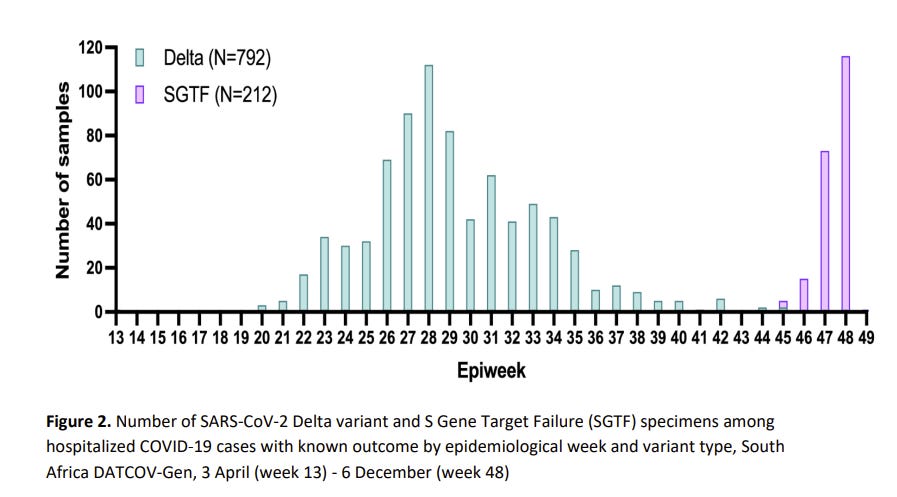
They don’t seem to be taking this problem seriously enough. Shouldn’t we be attempting to measure the decline in severity and hospitalization risk over time before Omicron shows up, here? That seems like a big deal, and we should have enough data to do it, and it should tell us what we want to know either way.
There’s also this problem, which might help rescue us from that first one.
This study has a number of limitations. Firstly, SGTF infections were only identifiable using the TaqPath PCR and only for specimens with high viral loads (Ct≤30) and therefore the number of SGTF infections is underestimated and biased towards geographic regions where this assay was more commonly used.
If the sample for non-SGTF includes non-differentiated data, that could muddy the waters.
This is from the discussion section:
When compared to non-SGTF infections, we found that SGTF infections had an 80% lower odds being admitted to hospital, but did not differ in the risk of severe disease among hospitalised individuals. When compared to Delta infections, SGTF infections were associated with a 70% lower odds of severe disease.
If severe disease risk among the hospitalized was the same, I’m not sure why the 80% becomes 70%? Are some severe cases not getting hospitalized? I’ve seen the theory that this is about differences in sample differentiation.
This seems like a good data point:
Our findings correlate with DATCOV surveillance hospitalisation data showing that, among patients who had a known hospital outcome, 32% of COVID-19 admissions during the early fourth wave were severe compared to 65% during the early third wave.
Meanwhile, let’s see how things are going around these parts. First, cases and deaths, with USA on for comparison. I’ll list the whole pandemic here for context.
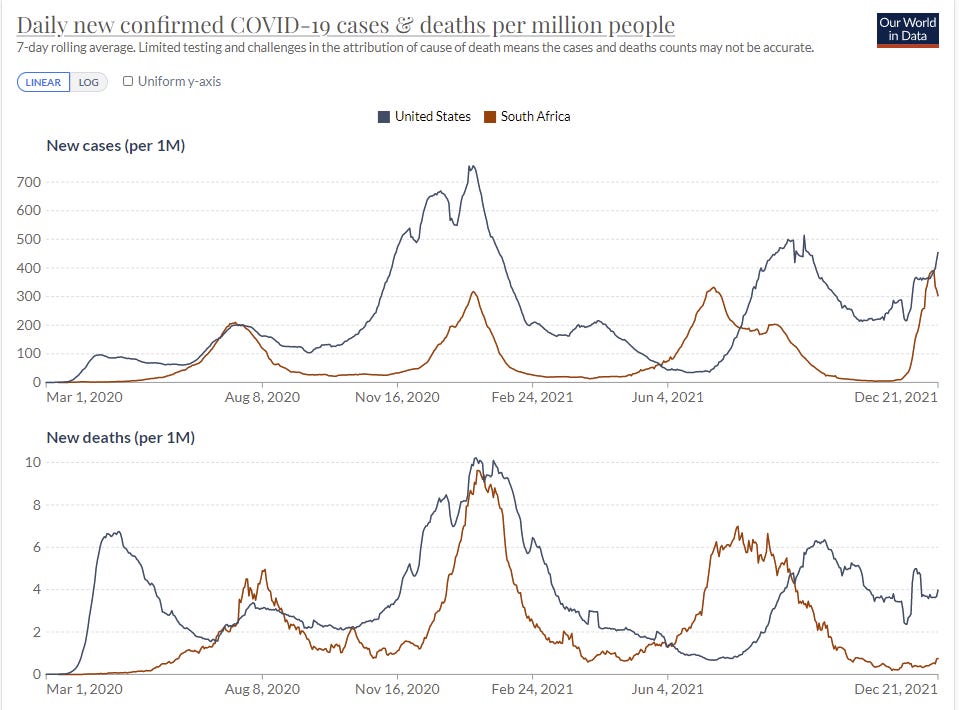
Sure looks like we’re past the peak, and the peak was remarkably low there, so low that it doesn’t make sense. Why would behaviors adjust this much this fast for so few cases, which were on average much milder? With almost no deaths, although it’s too early too expect that many yet? I don’t believe that happened.
Now hospital admissions.
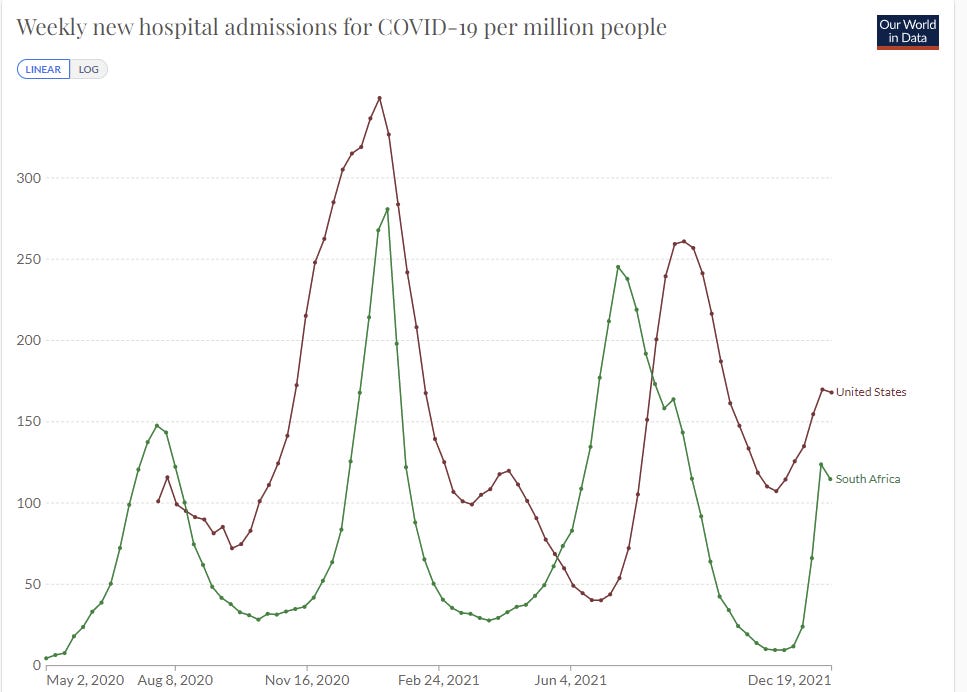
The hospitalization rate in the Delta wave is higher than in the late 2020 wave, but Delta is more virulent, so that makes sense but doesn’t tell us much. And the current wave we know doesn’t tell us much. So we’ll have to zoom in, and compare the start of the Delta wave to the end of the Delta wave and after it in times that still proceed Omicron, to see if there’s a big difference. If time is a big factor, we should expect a big difference.
I had a research assistant I’m trying out (fingers crossed!) assemble a graph for me, using six days of lag:

I consider this graph completely inconsistent with the theory that CHR was already decreasing a lot over time, so unless I’m missing something here (speed premium makes this very possible) I don’t think this is a serious problem.
That still leaves the problem that the effect is too large. We have too many other data points for an 80% effect to make sense as a general answer. Perhaps South African conditions are importantly different, and as usual perhaps controls were insufficient or we’re missing something else. Still, I count this as a pretty strong data point in favor of milder Omicron.
Here’s Kai’s take, which is largely a shrug emoji on the question of inherently milder.
United Kingdom
Commenters from the United Kingdom and especially London report dramatic changes in behavior. London is reported to be a ghost town ahead of Christmas. One of the few things happening are vaccinations, which are way up.
That could potentially explain why cases no longer seem to be continuously doubling at the previous speed. For a second it looked like they might have even stopped going up, but it seems clear that was at least premature.

Here’s where cases are currently growing (link to data).
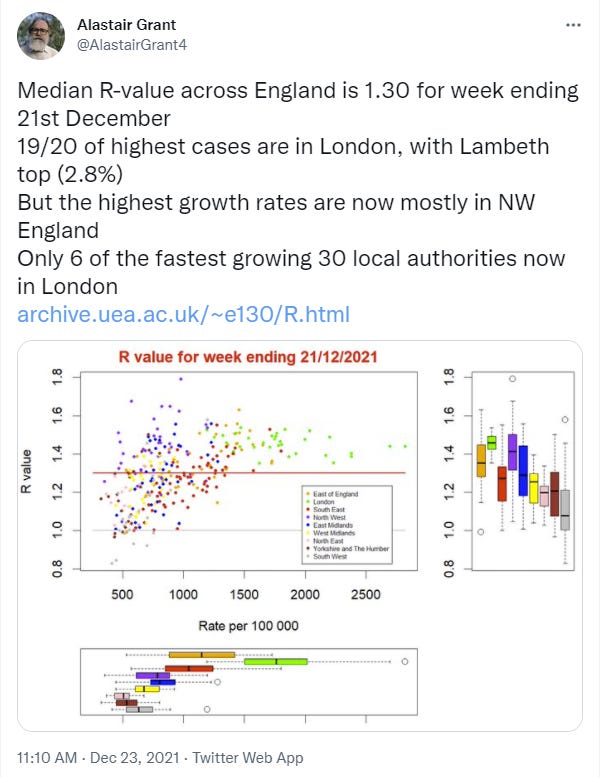
By this calculation cases are still growing everywhere, but no longer growing at the same pace (in log terms) as they were before, which will ‘flatten the curve’ a bit if nothing else. London no longer looks unique other than for its absolute case level, presumably because they did more adjusting and/or ran out of testing capacity.

The official recommendation says reduced likelihood of infection (same source), but the details say it may involve prior infection so they’re not claiming anything interesting there. That checks with the typical conservatism of such statements, where it’s more important (in the eyes of those making them) to not be wrong than it is to be helpful. They’re not even saying it’s clear that Omicron is more transmissible than Delta aside from immune evasion, which doesn’t seem plausible at this point.
This graph is new and interesting:
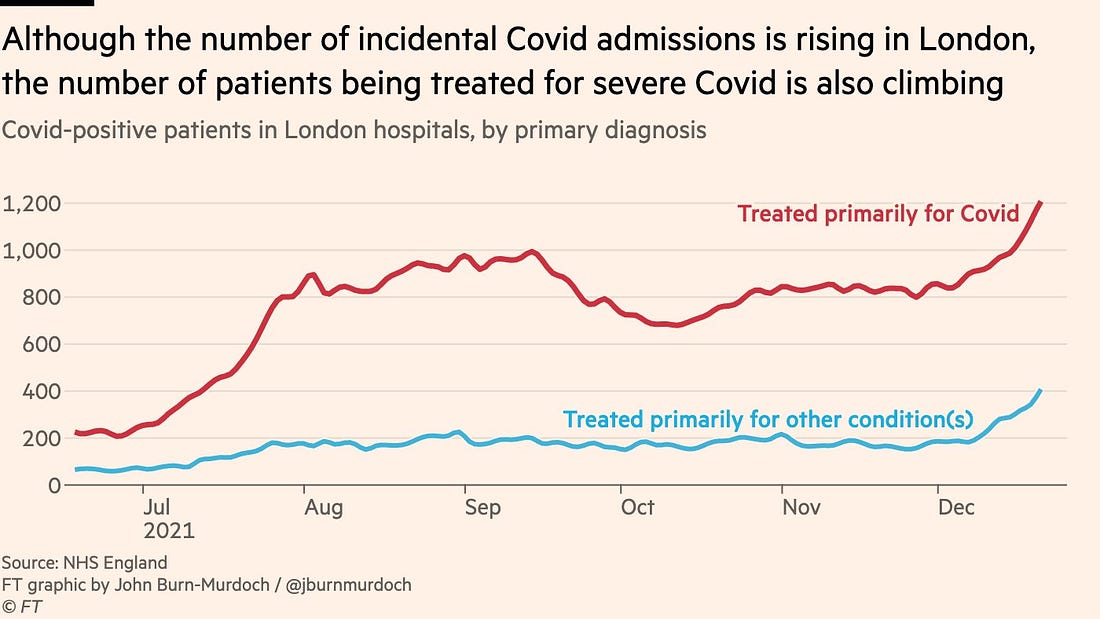


Need to keep all that in context, and we might be telling a different story by next week.

In any case, it’s mostly Omicron at this point, and soon it will be almost all.
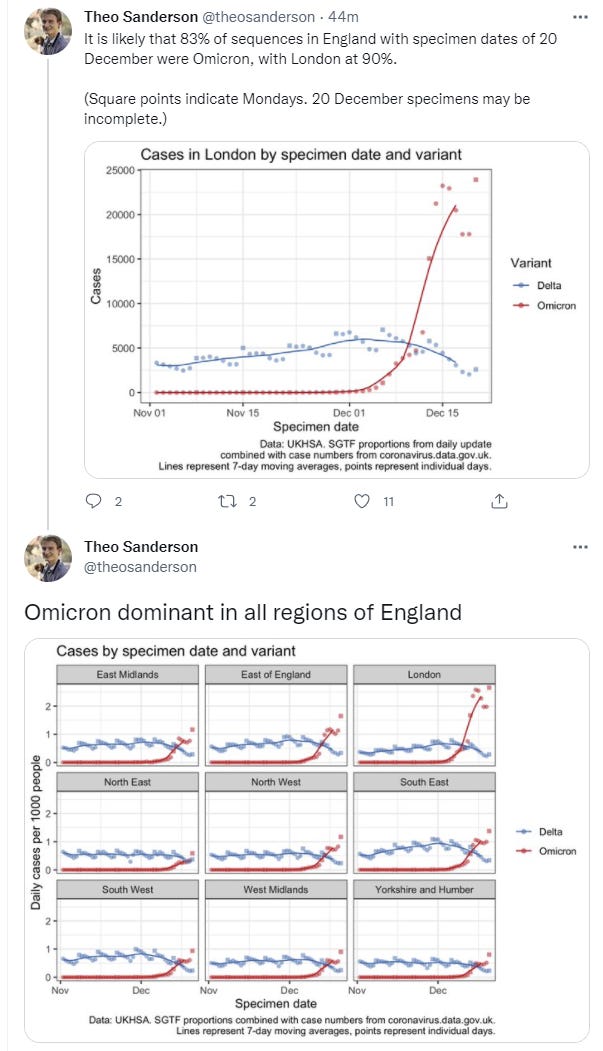
We’re not seeing much decline in Delta though, which is scary.


Denmark
Age data for hospitalizations in Denmark, the pairs of bars are weeks of the year ending with Week 50 of 52.
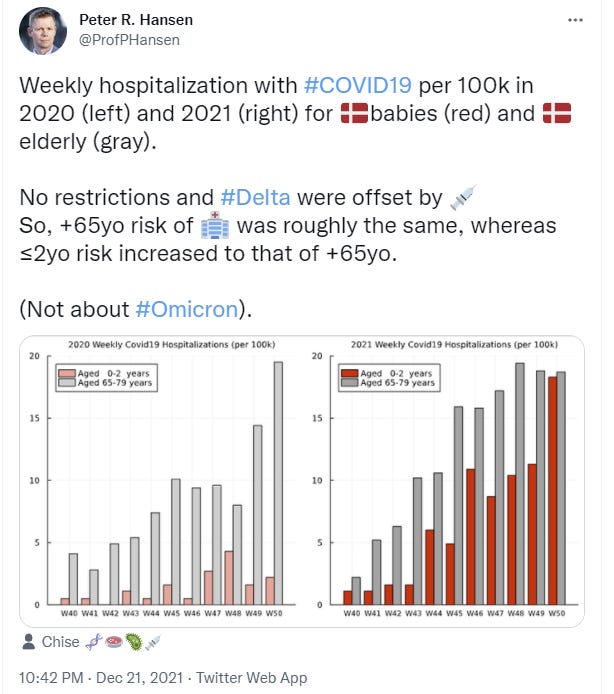

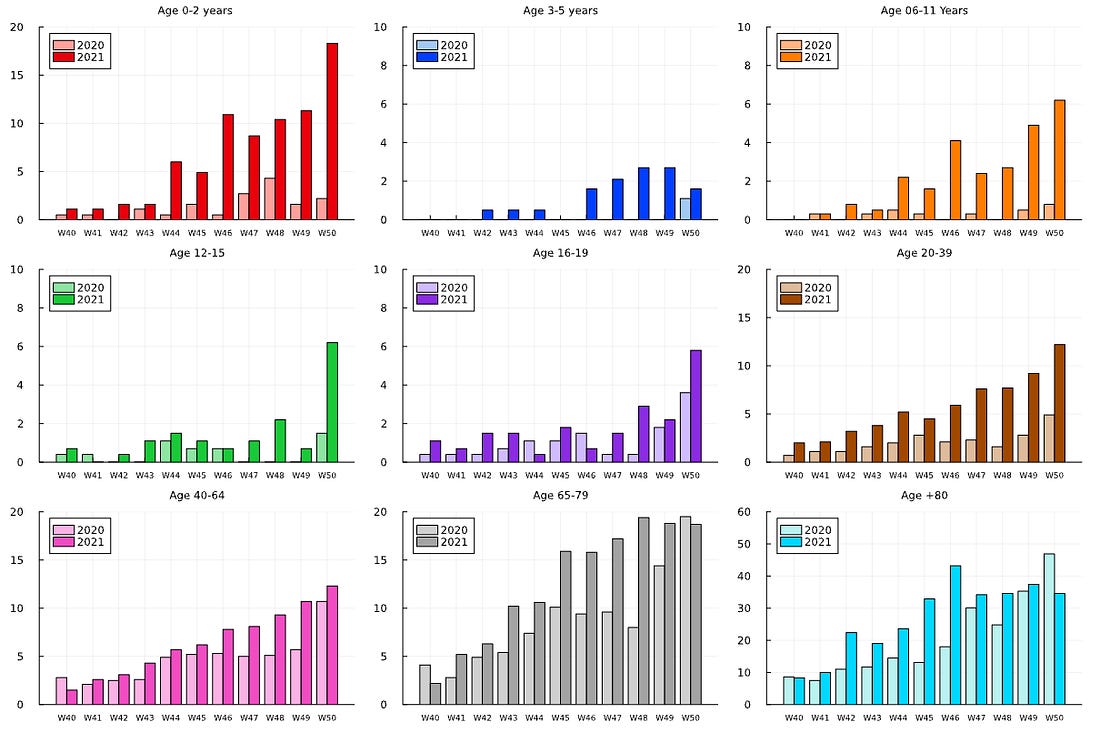
We’re seeing a large spike in cases in the 0-2 and 12-19 age groups, some growth in 6-11 and 20-30, a little in 50-64, and none in 65+.
Note that the graphs do not all use the same scale, so this doesn’t mean older people aren’t still at higher risk. That’s still about a 35 at the end, with no other group above 20. But the difference has shrunk quite a bit, which likely has a lot to do with who is getting infected.
My guess he’s right that this is about things being different in cities, but I don’t know Demark well enough to be sure.
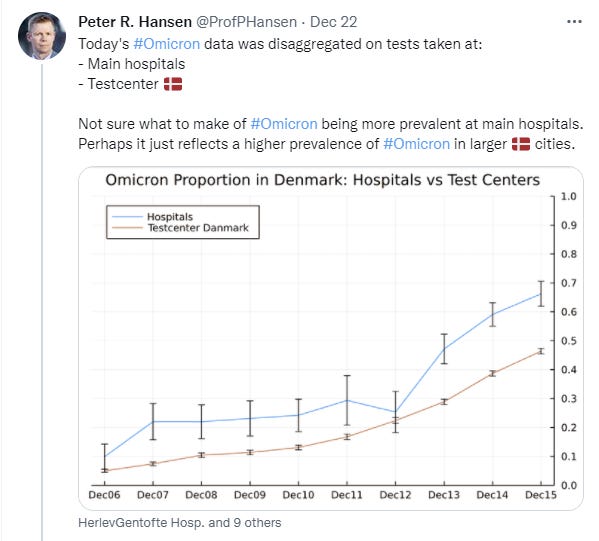
Note that this ends on December 15, so Omicron by now is almost all of the cases.
Case counts no longer seem to be doubling as rapidly, but they are still going up, and it’s likely we are starting to run into testing capacity constraints. Denmark has great testing but the number of cases is super high.
Around the World
China still plans to host the Olympics as far as we know, and that doesn’t seem like a great plan if they intend to go for suppression?

Canceling or delaying the Olympics to prevent a seeding event only if China makes it to February still going for suppression, which I find unlikely. I also don’t find it that likely that there’s going to be willingness to proceed in early February in any case, but perhaps we’ll be at full The Show Must Go On by then.
Anecdotally, I keep finding people saying ‘a bunch of people I know are sick, and that’s never happened before in the pandemic at once.’ Several of my commenters said it. My friend Spenser Greenberg said it on Twitter. Both my kids’ schools had a case. A coworker has a case. No one in my family tested positive, and whatever we had stayed mild, but I still have my suspicions.
The president and vice president each had a close contact.
I would describe myself as COVID-cautious at the moment, but I don’t think of it as competition to show virtue. I just notice that in the worst weeks of the past two years, the number of people that I personally knew with COVID never exceeded more than one per week, and the number was typically zero. Now all of a sudden, I know a dozen. They are not in the hospital, and they probably are not going to die, but they don’t seem particularly happy.
If you are not on the East Coast, you may not know what I’m talking about. Yet. But things are absolutely crazy here.
They also cancelled SNL, sending all but a few people home and throwing together a clip show. Resulting show wasn’t bad, they chose good clips and featured Tina Fey. The experiment with Weekend Update both showed that she’s still the GOAT, and how much the jokes there depend upon the background graphics that weren’t available this time.
Severity
Guardian piece from 21 December pointing out we don’t know severity yet.
Natalie Dean reads the Imperial College London paper (paper). As I understand her reading, the paper is suggesting a modest reduction in severity, and also giving estimates for the reduction for reinfections and vaccinations, which seem strangely low.
Now for my reading, here are the parts that seem important. First, what they controlled for is always important, note that prior infection isn’t included which is always a mess with Omicron.
We used stratified conditional Poisson regression to predict hospitalisation status, with demographic strata defined by age, sex, ethnicity, region, specimen date, index of multiple deprivation and in some analyses, vaccination status. Predictor variables were variant (Omicron or Delta), reinfection status and vaccination status.
Then the headline finding.
Overall, we find evidence of a reduction in the risk of hospitalisation for Omicron relative to Delta infections, averaging over all casesin the study period. The extent of reduction is sensitive to the inclusion criteria used for cases and hospitalisation, being in the range 20-25% when using any attendance at hospital as the endpoint, and 40-45% when using hospitalisation lasting 1 day or longer or hospitalisations with the ECDS discharge field recorded as “admitted” as the endpoint (Table 1). These reductions must be balanced against the larger risk of infection with Omicron, due to the reduction in protection provided by both vaccination and natural infection. A previous infection reduces the risk of any hospitalisation by approximately 50% (Table 2) and the risk of a hospital stay of 1+ days by 61% (95%CI:55-65%) (before adjustments for under ascertainment of reinfections).
A full admission of a day or longer seems like the more important data point than who sets foot in the room, so I’m going to file this as 40%. The reduction for previous infection is only 60% here, which is probably because so many such infections are entirely asymptomatic and missed. In any case, it suggests an upper bound for how much ‘but they already had it’ can explain in terms of reduced hospitalizations. If every South African already had Covid-19, but admissions conditional on infection are still down 80% as noted above, that’s still half the cases of a 60% reduction.
I don’t feel confident about the way they’re making adjustments and don’t have time to look closer, but this is another data point in favor of a modest reduction in severity after adjusting for everything, and for Omicron being similar to the original Covid-19 in severity, as opposed to either being similar to Delta, or it being substantially milder than the original Covid-19.
Interpretations vary, largely on the basis of what kind of mild counts as mild, versus what counts as about the same, and which numbers are worth looking at. E.g. if you look at ‘any hospital trip’ and think that’s the number that counts you get 20% instead of 40%:

Deepti has a long thread there.
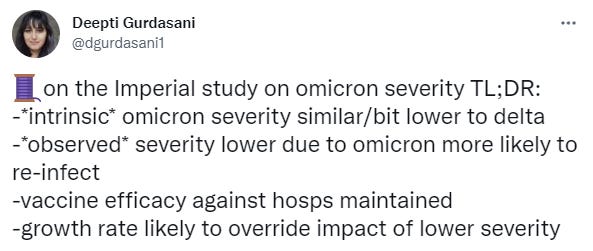
Her core message is that exponential growth will matter more than the severity reductions if allowed to continue. And of course, that’s very right. The right message to send depends on what the listener already knows, and what they need to learn.
There’s also data out of New South Wales in Australia, which lets us study Omicron in a population with a known vaccination rate and almost no previous cases.
Note in this thread he says CFR when he means CHR (case hospitalization rate).
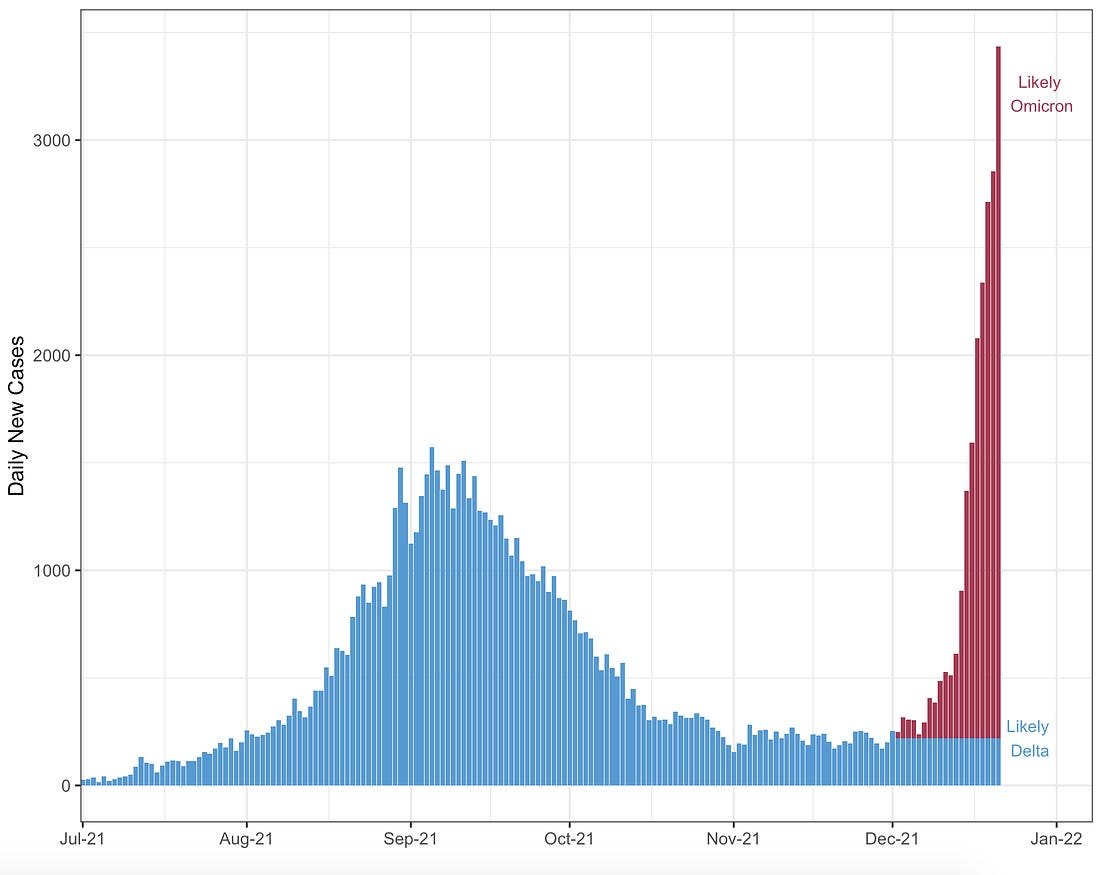


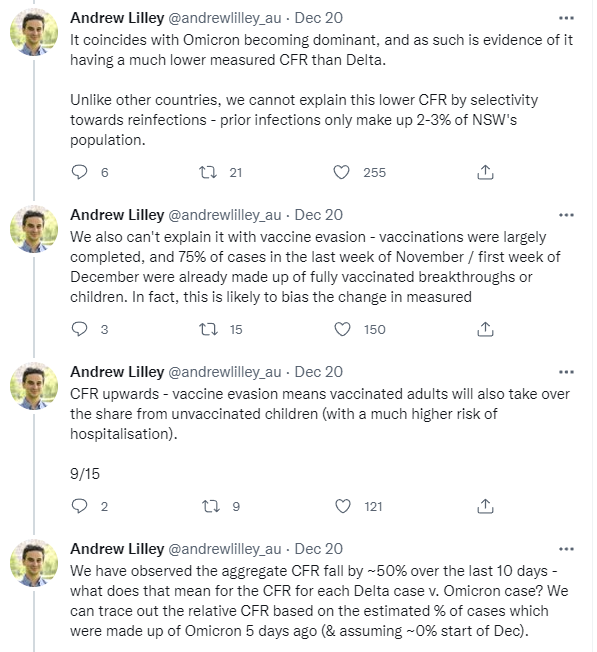
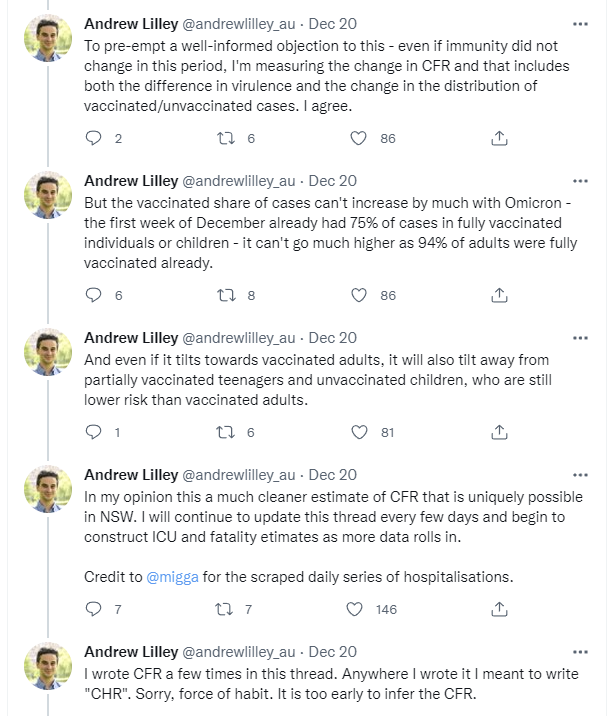
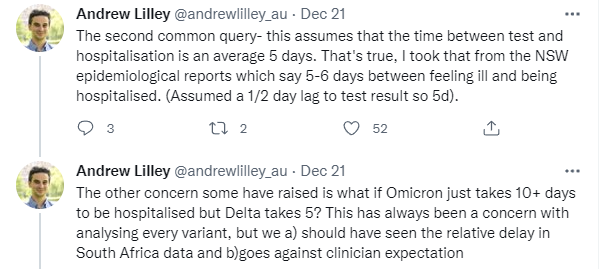
The argument thus goes like this. 75% of cases were already breakthrough infections, so that can’t go up much more than that, and can’t have much of an effect, as only 77% of the population is vaccinated. The change in composition there can’t possibly explain much of the drop from 6.9% to 3.6%. It’s also age adjusted, which takes the last big factor out of play.
I can’t verify from what I see that this properly covers the ‘not recorded as hospitalized yet’ factor, but assuming it does, this seems very robust to me, and represents a 45% drop in the hospitalization rate versus Delta, on the high end of the range of previous-to-the-update plausible answers. That’s a very close to the Imperial College result of 40%. Once again, we have a modest reduction that will help a lot, but won’t on its own save us from the grains of rice on the chessboard.
Then there’s the University of Edinburgh, with an analysis out of Scotland.
Here’s their methodology.
Using the Scotland-wide Early Pandemic Evaluation and Enhanced Surveillance of COVID19 (EAVE II) platform, which comprises of linked primary care, vaccination, reverse transcriptase polymerase chain reaction (RT-PCR), sequencing, hospitalisation and mortality data on 5.4 million (99% of the population), we undertook a cohort analysis with a nested test negative design incident case control study covering the period November 1 to December 19, 2021 to provide initial estimates of Omicron severity and vaccine effectiveness (VE) against symptomatic disease. We used S gene status as a surrogate for Delta and Omicron VOCs, with S gene positive status indicating Delta whereas S gene negative indicated Omicron. Cox proportional hazard models were used to estimate the risk of COVID-19 hospitalisation adjusted for age, sex, socioeconomic status, vaccination status and clinical risk factors. Generalised additive logistic regression modelling with spline terms for age and sex were used to estimate VE relative to ≥25 weeks post second vaccine dose.
Sample size is very large here. Their findings.
Findings
The first case of Omicron confirmed by viral sequencing was recorded in Scotland on November 23, 2021, By December 19, 2021, there were 23,840 S gene negative cases. These S gene negative cases were predominantly in the age group 20-39 (11,732; 49.2%). The proportion of S gene negative cases that were possible reinfections was more than 10 times that of S gene positive (7.6%
versus 0.7%). There were 15 hospital admissions in those S gene negative giving an adjusted observed/expected ratio of 0.32 (95% CI 0.19, 0.52). The third/booster vaccine dose was associated with a 57% (95% CI 55, 60) reduction in the risk of symptomatic S gene negative symptomatic infection relative to ≥25 weeks post second dose.
As a sanity check, they think the population with the s-gene deletion (Omicron infections) were expected to have about half as many admissions to the hospital, and instead they found only one sixth as many.
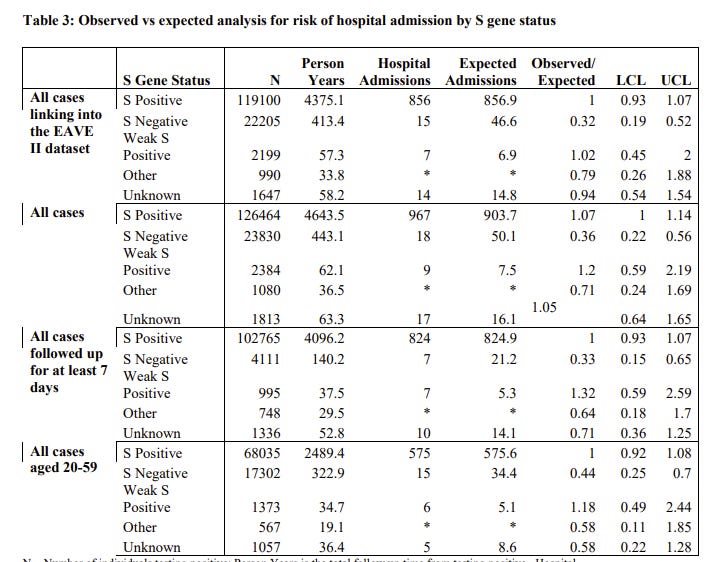
I definitely worry here that both they didn’t properly account for time lags (I don’t have enough time to be careful about this here right now), and that they failed to adjust for previous infection properly, but again that effect doesn’t seem like it can be big enough? So if we assume they’re missing some adjustment, we get that same result again.
Nate Silver attempts to reason from a price change (link to the Science post, which indeed is good at setting tone but also includes such insanity as ‘getting firm answers from the lab may take until Easter’).

In 2019 I would have bought the ‘people with money are saying’ argument, and in 2014 I might have thought it was this easy to associate the price change with what the market was thinking. I no longer think these things, nor is it that obvious why severity of Omicron (in terms of the range of 50% vs. 100% of Delta) should have that much impact on such stocks if you’re thinking long term.
Severity Synthesis
This is Natalie Dean’s guide to how to think about severity calculations, good stuff.
South Africa: 80% reduction in severity in the study, clear huge falloff in severity observed in practice, alternative explanations seem unlikely and their magnitudes contained. Testing is presumably inadequate in South Africa but they test when you enter the hospital, and that’s going to make it weird.
Imperial College: 40% reduction in hospitalization after adjustments if you count full stays, potential failure to account for all reinfections, but also missing unidentified cases as always.
University of Edinburgh: 65% reduction in hospitalization, likely didn’t fully account for missed reinfections (of course, also doesn’t properly account for asymptomatic infection rate this time around, either).
New South Wales: 45% reduction in hospitalization after adjustments, few prior infections so less unknowns.
Also, there was a study with 24 Omicron hospitalizations from earlier, and a bunch of other stuff.
So what do we get?
I see a consistent story of a modest reduction in severity, as measured by hospitalization risk conditional upon getting a positive test.
On top of that, there’s going to be some additional severity advantage based on a better chance to have a fully asymptomatic case and not even notice you’re sick, or know you’re sick but not get to the point you’re reporting a positive test.
Against that, I continue to worry about making the right adjustments for past infections, and I worry about everything happening too fast and the Omicron cases not having had enough time to get all the data in.
On top of that, in terms of problems per case, we get a big discount for having so many reinfections and breakthroughs, which will vary from place to place, but should at least cut things in half again. On a personal level, if you’re boosted, you get a lot more than that.
And of course, for as long as the health care system and hospitals hold up (although it’s already touch and go in places, and testing is definitely failing a lot) we’re a lot better at treating Covid than we used to be, so we should expect another advantage there.
None of this means all these studies couldn’t be making similar methodological mistakes, and missing the same necessary adjustments. That’s a real issue, there are lots of adjustments that could easily be quite a bit off. The whole thing is super complicated. Uncertainty should reign.
And of course, you can cut risk by half twice and have that get overwhelmed very easily if cases keep doubling, with everyone getting infected at once. But that’s also a worst-case scenario, an upper bound, and the chessboard ends. Would that upper bound royally suck? Oh yeah. Very much so. That’s still several hundred thousand deaths in America alone.
But, you know, it could be a lot worse.
Threads
21 December thread on situation in New York, which could turn ugly quickly.
Thread on what to do about positive tests, in which author notes that people are blowing up his phone about this. I only see so much increase in the official statistics for case counts, but I keep seeing these anecdotes, the real increase is much bigger.
Other
Novavax’s vaccine looks like it holds up very well against Omicron. It’s a real shame we never approved it.
Huge differences in testing rates depending on where you are in NYC. There’s indeed a lot more testing here, but there’s also a stupidly large amount of positive results of those tests, far more than the official numbers would indicate based on various anecdotal observations, as noted earlier – and since I wrote that, the list got longer.

Not that many hospitalizations, yet. But it’s coming. If after a week it doesn’t, that would be the other best possible news (in post #11, presumably).

Cause this is understating it, there’s some graphs at the link that locals may want to check out.
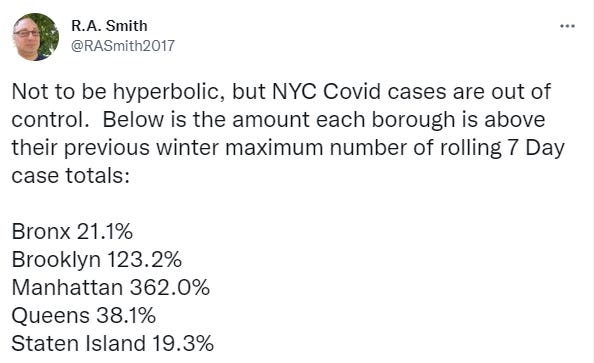
A lab worker got infected in Taiwan, and it seems they were bitten by a lab mouse. Draw your own conclusions. Bonus round, does this additional information the situation seem better or worse?

A theory that Omicron survives longer in the air than Delta, and that’s a lot of why it is more infectious.
The return of the Bad Reviews for Yankee Candles Index.


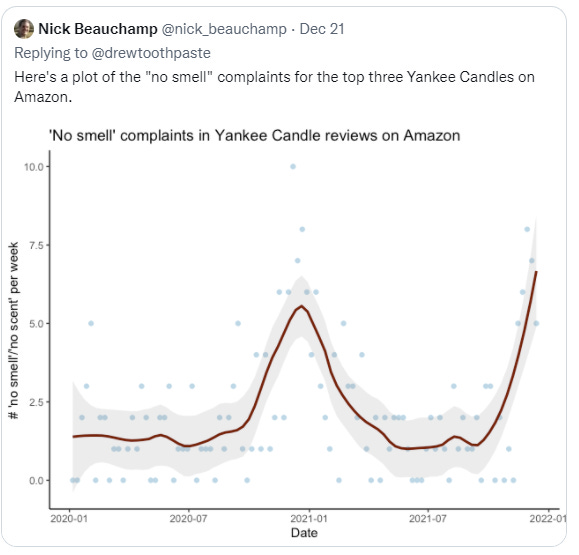
I agree that these words from Kelsey Piper are indeed wise. Here’s a link to her article about what to do if you get sick, and preparing for it to happen.
A note from a reader, on airports, that seems exactly right: It’s the constricted spaces that create the most risk, and we’re making little effort to increase throughput so that the lines would go away, despite it not taking much (if the traffic jam doesn’t back up continuously, and no one can leave since it’s an airport, it wouldn’t take much to clear the jam entirely):
I just flew home from Canada. The longest lines in the most constricted spaces were, predictably, customs and security. In both cases, there were facilities (scanners, customs booths) going unused. Adequate staffing would have eliminated the delays and reduced exposure. In the best case, it would have meant that some staff wouldn’t have been busy all the time, and there would have been no delays at all. That might have required 10% more staff, in a low-cost portion of the overall operation.
I keep forgetting to point this out, but yes, any and all quarantines between countries, any and all travel restrictions, are pointless by now unless you’re actively containing Omicron. Trying to contain who can come into the UK doesn’t make any sense whatsoever.
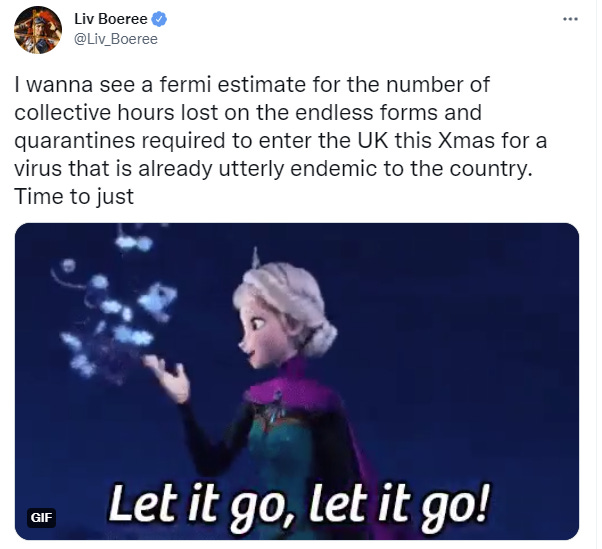
Predictions Update
Chance that Omicron has a 100% or bigger transmission advantage in practice versus Delta: 85% → 70%.
The generation time evidence opens up the possibility that we could be under this threshold, and the lack of full doublings is suggestive too. I still think we end up somewhat over it, but it would now surprise me a lot less. I would still be very surprised by there not being a substantial advantage anyway (50%+) on top of immune evasion.
Note that while this looks like me being less confident, that’s because my estimation is now closer to the 100% line, even though my error bars have shrunk. It’s not that I am more confused, it’s that I happened (mostly by coincidence) to set a good line.
Chance that Omicron is importantly (25%+ in the same person) more virulent than Delta: 3% → 2% (will delist this unless it goes back to 3% or more).
Chance that Omicron is importantly (25%+ in the same person) less virulent than Delta: 50% → 75%.
Chance that Omicron is vastly (75%+ in the same person)less virulent than Delta: %? → 15%.
Importantly is vague so I’m putting a number here, which I should have done before. That was a reflection of me being actually confused what ‘important’ meant. Now, I’m going to decide it’s this, and add a ‘vastly’ for a much bigger reduction.
My hunch is strongly that we’re looking at something like a 30%-60% reduction here, but there’s so many variables here and all the errors are potentially correlated. I’m not actually ready to declare the puzzle solved or anything. Still, it all adds up. The 15% is basically ‘the South African data is right and everything is great, happy new year’ scenario, and no matter how many adjustments people make I can’t dismiss it while few if any people anywhere are dropping dead.
Will the CDC label Omicron a variant of high consequence before 2022? 9% → 5%.
Look, no, they’re not going to do this at this point, it’s Christmas, everyone is going home, and I hadn’t adjusted enough for that before, the 9% at Polymarket is basically free money. I mean, anything’s possible, they did Paxlovid without much warning, but this seems so unlikely to happen in the next week.
Chance we will be getting boosters modified for Omicron within 6 months of our previous booster shot: 30% → 25%.
Things look less like a crisis, so it’s less likely they’ll push these on us, but if they make them I can totally see us trying to get people to take them anyway. Not giving much thought to this one recently, in any case, and my head’s spinning from all the things.
Chance we are broadly looking at a future crisis situation with widely overwhelmed American hospitals, new large American lockdowns and things like that: 30% → 20%.
We’ve seen more and more effective private adjustments, and more continued commitment to not locking down, and a generally good attitude, plus severity looks to be down. We especially haven’t seen European overreactions, and if they’re not gonna do it, we’re not gonna do it either. Then again, crunch time is still in the future.
Generation time (serial interval) of Omicron is 3.5 days or less: %? → 75%
This explains so much of what we’ve seen and makes so much sense. How else can something doubling every two days get slowed down all that much by private reactions? How could it be peaking so fast? The data from the cases in Norway backs it up. I’d love to see more similar data, which would quickly update me, but this seems important.

“We know that Omicron was doubling every two days around the world. Then suddenly maybe it wasn’t.
But if symptom onset comes in three days, and you’re infectious in two, then doubling every two days is perhaps only once per generation.”
I wasn’t able to understand this and that whole paragraph. Would someone kindly explain in different words what this means?
If the generation time of omicron is, say, 4 days, then to produce such a steep cases-over-time (doubling every 2 days) as we observed, it would need to have an R of 4. That would mean that throwing on enough restrictions to push R below 1 is simply not feasible, and also that it would infect a large share of the population in the course of the peak (overwhelming hospitals, etc.). However, if the generation-time is only 2 days, then R is only 2, thus it is both more feasible to stop it, and even if we don’t, it won’t infect nearly as many people.
(But if generation time were 8 days, then R would be 16, and we would be very f***ed.)
Thank you, I understood that!
Another to drive home the generation time vs. R0 trade off:
Imagine we have 1000 cases on Friday, and 10,000 on the next Friday. There’s two ways to get there, either each initial positive infected 10 people who took 7 days to test positive (R0 = 10, generation time = 7 days) or each initial positive infected ~3.33 people who then infected ~3.33 people 3.5 days later (R0 = 3.33, generation time = 3.5 days).
You might imagine we’re more scared of the high R0, low generation time scenario because it suggests this spreads like wildfire and will be enormous in a “sneak up on us” kind of fashion
Thank you, but don’t you mean “high R0, long generation time” at the end?
“They’re not even saying it’s clear that Omicron is more transmissible than Delta aside from immune evasion, which doesn’t seem plausible at this point.”
I am actually arriving to the conclusion that this not that implausible at all. Looking at the most current data I have at hand in Canada, the growth rate of new infections in the unvaccinated population is nowhere near exponential. The exponential growth in cases is only in the vaccinated population. There is modest growth in the unvaccinated population, but this could largely be explained by this sudden new massive reservoir of transmission in the newly-infected vaccinated population.
Consider the following data from Alberta, Canada:
December 5
—————–
72.5% Fully vaccinated (two dose)
4.8% Partially vaccinated
23.7% Unvaccinated
New Cases:
Vaccinated: 195 (44.83%)
Partially vaccinated: 10 (2.30%)
Unvaccinated: 230 (52.87%)
Alberta Population: 4,442,879
Vaccinated Population: 3,221,087
Partially Vaccinated Population: 102,186
Unvaccinated Population: 1,052,962
New Case Rate:
Vaccinated: 6.05/100k
Partially Vaccinated: 9.79/100k
Unvaccinated: 21.84/100k
December 21
——————
72.6% Fully vaccinated (two dose)
6.2% Partially vaccinated
21.2% Unvaccinated
New Cases:
Vaccinated: 1117 (80.94%)
Partially vaccinated: 10 (0.72%)
Unvaccinated: 253 (18.33%)
Alberta Population: 4,442,879
Vaccinated Population: 3,225,530
Partially Vaccinated Population: 275,458
Unvaccinated Population: 941,890
New Case Rate:
Vaccinated: 34.63/100k
Partially Vaccinated: 3.63/100k
Unvaccinated: 26.86/100k
——————————————————
In 16 days, the new case rate for the vaccinated population went from 6.05/100k to 34.63/100k, but the new case rate for the unvaccinated population only grew from 21.84/100k to 26.86/100k (LOWER than the new case rate for the vaccinated population!)
To me this screams similar or marginally higher transmissibility than Delta in the unvaccinated population, but insanely higher in the vaccinated population. I just don’t know how else to make sense of that. In fact, it’s so pronounced that I suspect the immune evasion is PRIMARILY vaccination immunity evasion, rather than previous infection immunity evasion.
I think this would go a long way toward explaining some of the counter-intuitive data we are seeing. If we accept that vaccination and prior infection are both conferring at least enough immunity against Omicron to prevent a large number of hospitalization (if nothing else) in those populations, but Omicron remains similarly transmissible to Delta among the unvaccinated with no prior infection, it is basically business-as-usual for those most susceptible to severe illness. Hospitalization should follow the growth rate of new cases in that population. In this situation, Omicron doesn’t even need to produce significantly less severe infections to explain the lack of hospitalizations relative to new case rates. (Though it would be awesome if that was ALSO true!)
Here’s the update from Alberta today (data through Dec 22):
December 22
——————
72.7% Fully vaccinated (two dose)
6.1% Partially vaccinated
21.2% Unvaccinated
New Cases:
Vaccinated: 1304 (79.71%)
Partially vaccinated: 16 (0.98%)
Unvaccinated: 316 (19.32%)
Alberta Population: 4,442,879
Vaccinated Population: 3,229,973
Partially Vaccinated Population:271,015
Unvaccinated Population: 941,894
New Case Rate:
Vaccinated: 40.37/100k
Partially Vaccinated: 5.90/100k
Unvaccinated: 33.55/100k
Growth picking up in the unvaccinated relative to the vaccinated, compared to yesterday, but new case rate still below that of the vaccinated population.
FWIW we see a similar pattern in the data from Ontario. Exponential growth in the vaccinated population, but not in the unvaccinated. On December 5, the new case rate in Ontario was 3.66/100k in the vaccinated, and 13.97/100k in the unvaccinated. As of December 23, the new case rate was 25.71/100k in the vaccinated, and 27.80/100k in the unvaccinated. Over the course of those 18 days the growth rate in the unvaccinated was not quite twofold, but it was a sevenfold increase in the vaccinated.
Maybe this exponential growth we are seeing, where we are seeing it, has a lot to do with the vaccinated case rate quickly catching up and even surpassing the unvaccinated in large part due to belief-in-immunity behaviours before we knew what Omicron’s immunity escape meant in real terms. Perhaps there’s an equilibrium reached when the case rates between the two populations converge, and behaviours adjust appropriately.
For those interested in a link to the Ontario data, here it is: https://covid-19.ontario.ca/data
See “COVID-19 cases by vaccination status.” A possible explanation is that omicron hit urban areas, where vaccination rates are higher, prior to rural areas.
LB: “A possible explanation is that omicron hit urban areas, where vaccination rates are higher, prior to rural areas.”
I believe the case rate per 100k data should smooth out the rural/urban divide. That’s the value of citing numbers per 100k instead of absolute numbers – since the absolute population size difference between vaccinated and unvaccinated groups is so large. If heightened transmissibility were leading to the same exponential growth in the unvaccinated group as the vaccinated, it should still show up on a per capita basis. It’s not. I believe what is happening instead is a convergence of case rates to the stable transmission rate within the vulnerable population. The vaccinated are suddenly a vulnerable population, whereas the unvaccinated already were. If their rate of transmission already was at or near the stable rate for Omicron – i.e. Omicron’s transmissibility is in fact similar to or not much greater than Delta’s – then it makes sense the unvaccinated wouldn’t see a large spike in growth, only the vaccinated would, since they were way under that stable rate of transmission before Omicron (and running around like they were immune the past 3 weeks.)
These numbers would also indicate that Omicron grows faster in the vaccinated population than any variant (including Omicron) grows in the unvaccinated population, which seems absurd.
My best explanation is that Alberta is just weird – either as a population (maybe everyone in cities is vaccinated & everyone unvaccinated is on a farm) or with their data reporting. Do you know if there is similar data from elsewhere?
The urban-rural thing makes sense and is sufficient to explain the effect, I think. Nearby in Manitoba, the one major city (Winnipeg) had been all done with Delta since June, while cases/hospitalizations/deaths were *overwhelmingly* concentrated in low-vax rural pockets. Now cases are mostly in highly vaccinated Winnipeg, while the less connected, lower density areas are getting a much slower Omicron bump. Probably 90+% Omicron at this point based on Winnipeg’s jump over last few weeks.
I think the case rate per 100k data should smooth out the rural/urban divide. That’s the typical reason to cite numbers as per 100k instead of absolute numbers – because the absolute population size difference between vaccinated and unvaccinated groups is so large. If heightened transmissibility were leading to the same exponential growth in the unvaccinated group as the vaccinated, it should show up on a per capita basis. It’s not.
In a reply to my own original message above I provide update from today’s numbers out of Alberta, I also cite numbers from Ontario that show a very similar pattern. Case rate growth in the vaccinated population is exponential, but in the unvaccinated population it is not. The new case rate for the vaccinated population hasn’t crossed the rate of unvaccinated like it has in Alberta – yet – but it has converged.
My working theory here is that within a given population there’s a stable rate of transmission and growth of cases among a vulnerable population for a given variant. Until Omicron, the “vulnerable population” was the unvaccinated. If Omicron were, say, similarly transmissible to Delta, or maybe only a bit more transmissible, it’s conceivable that the unvaccinated were already at or near that stable rate of transmission anyway. The vaccinated weren’t. The exponential growth of Omicron may simply be in the vaccinated population catching up to the unvaccinated to reach that stable transmission rate, now that the vaccinated are a vulnerable population too. Now we’re all essentially equally unvaccinated, and the transmission rate between the two communities is roughly on par with each other. The salient detail here being the lack of exponential growth in the unvaccinated population, which at least hints that maybe Omicron isn’t as hugely more transmissible than Delta in general, assuming that population cohort was already at the stable rate.
I think it’s reasonable to suspect – if not conclude – that the case rate between vaccinated and unvaccinated is more or less converging, rather than both groups experiencing similar exponential growth from their own starting point. I think it is shaking out that two-dose vaccination is offering essentially null protection against Omicron, and the case rate in the vaccinated is converging with the case rate in the unvaccinated as a result. I think a lot of the other anomalous aspects of these numbers can probably be handwaved away by confounders. For the past few weeks, the vaccinated were still running around like they had immunity, while the unvaccinated weren’t. The vaccinated may get tested for COVID at a higher rate than the unvaccinated, somewhat artificially inflating their test-positive numbers. Naturally conferred immunity may provide better protection against Omicron that two-dose vaccination, meaning on average the unvaccinated DO – in aggregate – have higher defense against Omicron, since the unvaccinated probably have a higher percentage of people with previous infections than the vaccinated.
In any case, this data is sure making me scratch my head and think about alternate theories as to what exactly is going on here. It’s weird.
@Graham Blake
“I think the case rate per 100k data should smooth out the rural/urban divide.”
I should have made the argument more specific. It’s not that urban areas are bigger than rural areas. It’s that urban areas are more cosmopolitan. New strains originating in other countries reach the cities first, and then spread into the countryside. So we are in a brief period of time when we have Omicron in the cities, but only Delta in the countryside.
I predict that the case rate among (less vaccinated) rural areas will increase dramatically in the next week as Omicron makes its way there.
@thechaostician
“So we are in a brief period of time when we have Omicron in the cities, but only Delta in the countryside.
I predict that the case rate among (less vaccinated) rural areas will increase dramatically in the next week as Omicron makes its way there.”
I agree that this in particular could have some effect – there being a larger pool/ratio of vaccinated people to attack first in urban areas – and I believe that could fully explain why the new case rate is (currently) bizarrely higher in the vaccinated population, but I still think the difference in growth rate is so staggeringly large between the two populations that there has to be something else in play. Despite the high rate of vaccination in the urban centres, approximately 60% of unvaccinated population of the province is still found in the two main urban centres. That is a LOT of unvaccinated people between those two main urban areas (about 600,000), and that should be sufficient to show significant growth in absolute numbers as well as per capita in that population. Were that strictly an urban/rural divide skewing those numbers, you’d think that should show still at least show “60%” of the growth rate in the unvaccinated population, relative to the vaccinated, or at least some sensible fraction approaching half. Instead it’s a new case rate growth of almost 6.67x in the vaccinated population over 18 days, but only 1.54x in the unvaccinated.
I do think this hints at the stable rate of transmission for Omicron being close to that of Delta. Maybe not exactly the same, maybe a bit higher, but not like 5 fold higher as some earlier estimates suggested. If the unvaccinated were already catching and transmitting Delta at or close to the stable rate of transmission of Omicron when Omicron appeared on the scene, it could explain this divergence in growth rates between the two populations. It’s a rapid convergence of two populations to a similar rate of transmission instead of exponential growth in two populations from their respective starting points.
I also think we have to look a bit suspiciously at the relatively low growth rate in the unvaccinated population in another respect as well. Were Omicron exactly as transmissible as Delta in the unvaccinated population, we would still expect to see an increase in the new case rate in the unvaccinated population due to the larger number of infected persons at large in the world with the newly vulnerable vaccinated population all joining in and infecting others. It’s like the number of people available for conscription into the Army of the Infected grew fivefold overnight. That alone should drive some of the growth in the unvaccinated population, which just makes the relatively low growth rate there even more peculiar, because an even smaller magnitude of it can be attributed strictly to Omicron’s presumed greater transmissibility alone.
Predictions:
– Omicron is <2x more transmissible than Delta in the unvaccinated population (80%)
– Omicron is <1.5x more transmissible than Delta in the unvaccinated population (60%)
– The rapid case growth of Omicron is more significantly attributable to the large newly-vulnerable vaccinated population than an inherent advantage in transmission vs Delta. (65%)
– The higher rate of new cases in the vaccinated population than the unvaccinated in Alberta is a temporary artifact, likely attributable to the "cosmopolitan effect", and that the new case rate in the unvaccinated will, in the very least, reconverge with the vaccinated.(80%)
– Two-dose vaccination provides effectively zero protection against symptomatic infection with Omicron. Or, at most, it provides a level of protection approximately equal to the share of the unvaccinated population (in Canada) that has had a prior infection (+/- 10-20%), so that in aggregate the two populations share an approximately similar level of protection against Omicron, and will arrive at a similar rate of infection. (75%)
– Two-dose vaccination and prior infection provide a strong level of protection against hospitalization and death from Omicron and the most vulnerable population to severe illness with Omicron remains the same as with Delta – the unvaccinated with no prior infection. Hospitalization growth rate will track case rate growth in the unvaccinated with no prior infection population much closer than the case rate growth in the population as a whole. (80%)
One more updated data point on this: The December 24 7 day average data from Ontario show convergence and a new case rate in the vaccinated that even exceeds the new case rate in the unvaccinated slightly.
Ontario, December 24 New Case Rate (7 day average)
Vaccinated: 32.39/100k
Unvaccinated: 31.93/100k
On December 10, that 7 day average new case rate was:
Vaccinated: 4.71/100k
Unvaccinated: 15.63/100k
The more data points I see like this, the more strongly I feel that the growth rate in the unvaccinated population is the more significant number to focus on for getting a handle on Omicron’s transmissibility relative to Delta. I believe the rapid convergence (and even overshoot) in the vaccinated population to the new case rate of the unvaccinated is significantly responsible for the initial exponentiality of Omicron’s growth. I don’t really know how to math it out, but I strongly suspect that much of the (relatively modest, and somewhat typical of previous waves) growth rate in the unvaccinated could largely be attributed to the number of potential vectors of transmission increasing fivefold practically overnight, as the vaccinated population was suddenly recruited into the susceptible pool, instead of blocking chains of transmission. This lowers the bounds on Omicron’s inherent increase in transmissibility in my estimation.
>Many of them are doing so in order to ensure they can still have their family Christmas,
Two possible readings here, maybe one of which is not intended. Lol.
“We especially haven’t seen European overreactions”?
Netherlands is locked down. Germany is locked down – no christmas markets even ;(
German here. Christmas markets were closed in response to the huge Delta wave. As a response to Omikron, we now get closed clubs, private meetings restricted to max 10 vaccinated adults (drops to one adult guest if unvaccinated and children not counting), a few restrictions on restaurants + sale of fireworks verboten. You can decide if this is adequate or insane on your own, but I don’t think it qualifies as a full lockdown.
If you believe that raping people for fun is adequate, then this is also adequate. If you believe that we should be a society of rights, then all of politics was completely insane long before this pandemic. There is no middle ground. I don’t see how anything they’ve been doing is compatible with the concept of a person being anything other than an object owned by the state.
I predict you will go higher on omicron being importantly less virulent.
I also predict you will introduce ‘3 mRNA shots are ineffective at preventing symptomatic (but mild) disease from omicron.’
Thanks for writing.
I seem to remember now something about early data from Delta being confusing in a similar way and having a similar explanation. Estimates of the reproduction number using its growth rate were really high, but then the numbers peaked abruptly. We reconciled these by figuring out that the generation time was shorter.
I’m surprised that more people weren’t thinking about generation time as much from the beginning with Omicron. I’m of course one of the people who didn’t think of it. It seems like something we could have learned from the last important variant.
Glad you found the hospitalization/cases chart that I tweeted at Nate useful. Happy to update it for your next post or make other charts for NYC that you’re interested in.
I am definitely interested in how things are going locally. What’s the source so I know what we have to work with?
I downloaded the Hospitalization and Positive Test tables from NYS (filtered for the NYC region):
https://coronavirus.health.ny.gov/daily-hospitalization-summary
https://coronavirus.health.ny.gov/positive-tests-over-time-region-and-county
https://nymag.com/intelligencer/2021/12/is-omicron-a-new-wave-or-a-parallel-pandemic.html <- I found this theory pretty terrifying. Two parallel pandemics are on the go, one with an advantage in the vaccinated and one the unvaccinated, each conferring minimal immunity to the othr
When considering the Intelligencer article, I think it’s important to distinguish between protection against infection and protection against severe disease. It seems clear at this point that vaccines and prior infection (with a non-Omicron strain) are much less protective against an Omicron infection. The article makes the point that the same may be true in reverse, i.e. that prior Omicron infection doesn’t protect well against Delta infection. That seems quite plausible to me, although we’ll have to wait for enough people to recover from Omicron infection before we can be sure.
Sorry, hit Post too early.
Despite the foregoing, we think that the vaccines and prior infection do confer protection against severe Omicron disease. Is there any reason to think that Omicron infection won’t protect against severe disease from a subsequent non-Omicron infection? I suppose that’s possible, but it seems unlikely. So it is likely that the unvaccinated who get Omicron will still be protected against severe disease. If it turns out that most of the unvaccinated are infected this winter, it’s possible that the Omicron wave will be the last one to cause a large number of hospitalizations and deaths.
Denmark numbers support the notion that growth in infections and reduced severity roughly offset. 7 day average number of positive tests a month ago (pre-omicron) was about 4000. That has increased to 11,000 but new cases have declined slightly each day for the last 3 days. New cases reported Dec 24 are the same as Dec 17. Positivity rate is declining.
Between Dec 16 and Dec 24 number of hospitalizations has grown from 517 to 538. Patients in ICU from 61 to 74. Number of patients on a ventilator has declined from 42 to 39. These current hospitalization stats are not much different from what could have been projected in November, before the new variant was widely reported.
https://www.sst.dk/en/english/corona-eng/status-of-the-epidemic/covid-19-updates-statistics-and-charts
The Yankee candle index is really interesting in that some early reports suggested Omicron had fewer symptoms and specifically was less prone to cause loss of smell. Yankee Candle index says no, loss of smell is still a big issue in the current covid spike. Maybe loss of smell is less common among the people going to the hospital but not “asymptomatics”, or maybe it was just bad data.
Zvi, I’m a little confused by your continued calls for caution around Omicron on a *personal* level despite the following facts:
1. Even without the vaccine COVID very rarely resulted in hospitalizations for healthy people under the age of ~50
2. With the vaccine hospitalization odds are now 1 in ~1000 (rough ballpark figure), condition on you being otherwise healthy
3. With the booster those odds increase even further, possibly down to 1 in ~5000
4. You’ve personally had COVID by now and it was mild for you (I believe?)
5. You acknowledge that data is pointing towards Omicron being more mild or at least not worse than Delta for the vaccinated
6. We have pretty good data showing that Long COVID odds are much lower than previously thought (your link to the corrected UK study)
If so… why would any healthy person under the age of 50 take any precautions whatsoever? I get it – for society as a whole some precautions would be wise, but what is there to fear on a personal level? Or is the idea that many age groups / health status people read your blog, so you’d rather just project a simple “5 words” message than break it down further? Or maybe I’m imagining things and you’d advise a healthy <50 year old to go out there and get Omicron without a worry in the world?
I agree that if all you are worried about is your personal risk, and you are boosted, you should not be worried unless there is risk of hospital overload. I there is risk of hospital overload (which is nonzero at this point, if you get infected soon) one might want to arrange different timing.
Personal anecdote – now have heard from many young, healthy friends who have contracted covid in the latest wave, probably omicron. Highly unscientific sample, but the breakdown seems to be about 50% super mild cold, 50% reasonably bad flu.
Everybody I’m hearing from was vaccinated; I don’t know how many boosted.
One reason to take cautions might be to delay infection until you get a booster if you want to avoid the “flu” variety of symptoms.
Hmmm – if in a pre-covid year the flu was normal in its symptomology but everyone was getting it, would I take precautions? Probably.
I would stay home if I was symptomatic and get tested as soon as it was convenient.
A small point but London has not been a ghost town at all. At least not in the suburbs. Well not in my suburb at least where the cafes are absolutely rammed.
Beyond the scope of this post but if omicron becomes the dominant strain and it’s got vaccine escape, one wonders how much longer the authorities will insist that past infection is irrelevant when it comes to mandates.
For omicron, it appears so far to be the Only effective immunity.
Zvi, do you have any updates on the hospitalization/death risk after the omicron infection? IIRC, you have previously assumed that omicron is 80% as bad as delta, but now I hear that the hospitalization risk is ~70% lower.
What would be the baseline risks of hospitalization and death?
I assume that two shots of Pfizer 8 months ago can still reduce these risks further by ~70%?
I think there’s still some collective breath-holding on this, as hospitalizations and (especially) deaths are a lagging indicator. Judging from some of the more very recent data out of Canada, previous vaccination appears to remain very effective against hospitalization. Effectiveness of vaccination against symptomatic infection has fallen to near-zero, but vaccine effectiveness remains >80% against hospitalization in the numbers I am tracking most closely. (Based on who is currently in hospital right this second.) This level of effectiveness is a little bit below what it was a month ago (85-86%), and this may fall further in the days ahead, but so far it hasn’t started falling as far or as fast as I might have feared. It at least suggests there isn’t a massive wave of the vaccinated infected flowing into hospitals so far.
Using Alberta, Canada numbers. The current rate of those hospitalized who were vaccinated is 3.68/100k, and among the unvaccinated it is 20.17/100k. On December 4 it was vaccinated 3.84/100k and unvaccinated 26.69/100k. Since the rise of Omicron, the rate of hospitalizations has actually gone down in both populations, but the vaccinated now have a slightly higher relative rate of hospitalization than they did pre-Omicron. (Vaccinated rate was 14.4% that of the unvaccinated rate 3 weeks ago, and now it is closer to 18.2%.)
I think it is going to take a few more weeks to tease out various effects from one another. Hospitalizations remaining relatively flat can have several explanations, and likely a combination of several explanations. On net, I would estimate (guess) there is a slightly elevated absolute risk of a (two-dose) vaccinated person ending up in hospital with Omicron vs Delta, but maybe not alarmingly elevated? Like 10-20% more likely? Considering the absolute risk of a symptomatic infection in a vaccinated person has gone up probably tenfold or more in most places, but the risk of hospitalization hasn’t, the percentage of the vaccinated with breakthrough infections who end up in hospital is probably very low compared to Delta. I don’t know if it’s possible at this stage to say that this is because Omicron is inherently less virulent, or if it’s because the composition of the population with breakthrough infections has completely changed. (I suspect it’s largely the latter.) Breakthroughs in the vaccinated with Delta were skewed toward the immunocompromised, with Omicron all the vaccinated are susceptible now. It may be that it remains primarily the immunocompromised to are at most of risk of hospitalization with an Omicron breakthrough.
In short, individual risk of hospitalization is probably something similar to what it was with Delta. If you live with conditions that put you at higher risk of complications, then you should probably assume an Omicron infection is a similar danger. If you’re in a low risk population, and have had two vaccination doses, your risk of symptomatic infection is very high, but the risk of severe illness is probably very low. Probably about as low as Delta, except where with Delta you’d likely never have gotten sick in the first place, with Omicron you will.
Thank you for a detailed take, Graham! I still hope that one of the key reasons behind the stable hospitalization/death rates with rising infection numbers is omicron’s lower virulence. If it was 60% as bad as delta, and if the double vaccination lowered the hospitalization/death risks to 25% of the unvaccinated baseline, then it would make omicron a kind of unavoidable flu for most of the younger and healthier people.
I have a rapid testing program in place at my business, which involves a few dozen employees with close contact between each other and the public that can’t be easily mitigated, in an industry that’s too important to shut down in the old 2020 “abundance of caution” style. So far rapid tests have caught our few cases very early and prevented further exposure. Two areas of uncertainty I’m trying to figure out on the fly…
1) I saw some reports and literature that saliva/throat swabs turn positive somewhat faster than nasal swabs, and if that makes rapid tests even a few hours more sensitive that’s a huge win. On the other hand, the usual CYA and doing things by the book concerns, which don’t carry much weight for me.
2) With so much uncertainty about Omicron generation times, what sort of infectious pre-symptomatic window and typical infection/infectious/symptomatic timeline can we expect? I’ve already switched from every-other-day to daily testing, plus more for anyone isolating with possibly non-covid symptoms, but nasal swabs aren’t giving positive results until very close to symptom onset, which anecdotally seems to be 72-96 hours after exposure (if identifiable). It would be great if someone did a study tracking PCR Ct values every few hours for both nose and throat swabs against rapid test results specifically for vaccinated Omicron cases, as that would inform how far back to look at potential exposures and so on. I’m confident that rapid tests are catching the most infectious immediately pre-symptomatic window just fine, but I don’t know what they’re missing at the lower-probability early end.
More generally, given an ample but not infinite supply of Abbot tests, what sort of testing and isolation protocol will minimize employees getting sick at work without wasting too much of anyone’s time? It seems like the various windows and timelines suggested by the public health people are way out of date now.
Very strange Danish vaccine study that’s been making the rounds among some of the more well-informed antivaxx-adjacent folks I follow (ie, spaces where the prevailing view is that over-40s should get their shots but not anyone else–to be clear these views piss me off but they have been a source of some interesting information in the past).
https://www.medrxiv.org/content/10.1101/2021.12.20.21267966v3
Plausible-looking numbers for vaccine-effectiveness (vs infection) against Delta. Against Omicron, they find some effectiveness for a few months and then high *negative* effectiveness. Authors say that these numbers are likely confounded. The Skeptics are saying this is “original antigenic sin” rearing its head.
Anyway, may be worth thinking about if only to figure out what’s wrong with it.
Using a simple screening method, we are now seeing negative apparent effectiveness of vaccination in Canada vs. Omicron. In at least two provinces the new case rate per 100k is higher in the vaccinated population than the unvaccinated population. A simple screening method, while useful to get a general picture of vaccine effectiveness, is riddled with confounders though, especially with a rapidly changing profile of susceptibility in the population. It seems likely the negative apparent effectiveness will come out in the wash.
It does seem plausible that prior infection provides a stronger protection against symptomatic Omicron infection than two-dose vaccination, and this could be skewing apparent vaccine effectiveness values lower. If 100% of the vaccinated are susceptible to symptomatic Omicron infection, but only 70-80% of the unvaccinated remain susceptible, that will have a huge downward pressure on apparent effectiveness. I don’t know if that alone qualifies as original antigenic sin though. Some people will no doubt cheerfully ignore survivorship bias in that scenario, and claim so.
That definitely wouldn’t count as OAS. I think the survivorship bias has to be part of it, but since the numbers for Delta look normal, it’s hard to believe that that’s the whole story? Or maybe survivorship plus vaccine evasion is enough to get an appearance of negative effect?
@Dave, take a look at page 24 of the data below from the UK (which I also tweeted to Zvi to make sure he saw it).
it seems to say that effectiveness against infection with Omicron, from 3 doses of Pfizer, declines to just 45% ten weeks after the *booster* shot (for all we know, it could get even worse after that but their data only goes that far for now). Since already only a minority of vaccinated people had their booster at all, and even fewer had it in, say, in the past 5 weeks, it seems vaccinated people will have extremely limited protection against Omicron.
I do wonder if this will increase vaccine hesitancy. The vaccine was originally sold as a way of protecting yourself and others, and potentially even a path to herd immunity — which obviously requires effectiveness against infection. The FDA required at least 50% efficacy against the primary endpoint, which was infection in the studies the drug makers did. So if the UK data below holds up it seems like the vaccine would not actually clear the FDA’s originally stated hurdle. I also think there may be a sort of commonsense notion among many ordinary people that the vaccine didn’t “work” if they took it and then got sick with COVID anyway.
It seems like Omicron might well be the breaking point that causes us to “give up” in a lot of different ways — but one of those may be vaccine uptake, where we might have already hit the high water mark of public openness to suasion on the vaccine. If a lot of vaccinated people get sick and normal people start to think the vaccine just doesn’t work very well, I would think more will be sympathetic to the anti-vaxxers, and support for any kind of mandate or harsh efforts to force vaccine compliance would decrease.
Click to access technical-briefing-33.pdf
So far at least it appears even two-dose vaccination continues to offer robust protection against hospitalization with Omicron. As long as that remains the case, there is still a strong argument for vaccination and arguably even mandates and passports. If we accept protecting health care capacity as a bedrock principle of the public health response, then it continues to make sense to support vaccination and higher levels of restrictions imposed on the unvaccinated as long as that continues to reduce hospitalizations. At least for as long as the health care system remains under threat.
With luck, we come out of this wave with so few people lacking enough immunity to reduce the risk hospitalization that it will be a non-issue. We may already be there given the rather modest increase in hospitalizations with Omicron so far. This may in fact be the cross-over point to where COVID is a bad “common cold” for those with some immunity, and it will no longer present an ongoing threat to health care capacity.
@Graham Blake — To be clear, I of course think people should still get the vaccine. It’s cheap insurance against a really bad outcome, and it is extremely safe so easily passes any cost-benefit analysis.
My point is more of a question about how ordinary people will react. Whether they *should* continue to get the vaccine/all available boosters is a different question from whether they *will*. While I would still expect most people to keep following the guidelines no matter what, I think a lot of breakthrough cases could cause a few consequences: (i) a big chunk of people at the margin who otherwise would have ultimately will decide not to get more boosters or comply with vaccine recommendations, (ii) public opinion might shift more decidedly against “mandates,” (iii) there might be a jolt of support for anti-vaxx movements more broadly going forward, including with respect to childhood vaccinations that were not controversial until recently.
I can’t really think of an example where there was such a high-profile vaccine that literally everyone got — and that failed so spectacularly to prevent symptomatic infection from the disease it was supposed to immunize against. I’m not sure people are really prepared to accept the idea that a vaccine was “effective” if they got infected with the disease at issue and felt clearly sick, but didn’t end up dead or in the hospital. Stories like the one linked below also would seem to be very damaging to public confidence if they hold up in the data longer term (basically noting that more vaccinated people per capita have become infected with Omicron than unvaccinated people). While there are reasons that can be reconciled with other things we know about the vaccine, those reasons might be a little too complicated to be persuasive to ordinary people, who could easily interpret this as, “the vaccine puts you at greater risk of omicron than just not being vaccinated.”
It seems to me the core mistake the government is making is trying to pretend like we don’t need Omicron-specific boosters and that the existing vaccine is fine, when it seems like we really do need updates. It would be a perfectly good explanation if they said “the vaccine you got protects against original COVID; omicron is in many respects a new disease and unfortunately you’ll need a new shot.” They’re too slow to actually approve an Omicron-specific booster in time, however, so they’re trying to claim this vaccine is effective against Omicron, even though the public probably may not accept a vaccine with widespread breakthrough infections as “effective.”
https://nymag.com/intelligencer/2021/12/is-omicron-a-new-wave-or-a-parallel-pandemic.html
@John H.
I think these are largely messaging problems. What we are seeing with Omicron is well inside the range of expected outcomes that we were facing all along. Right from the outset, if people were paying attention, there were caveats expressed about vaccine effectiveness waning over time, potentially requiring future boosters, and/or variant changes that would otherwise alter the effectiveness of first generation vaccines. You’ll get no argument from me if you want to say that public health messaging has been a mess, but beyond trying to make public messaging less of a mess I do not really know what more we can do about people (often wilfully) failing to grasp nuance.
Digging into some of the nuance:
“noting that more vaccinated people per capita have become infected with Omicron than unvaccinated people”
This is almost certainly an artifact of confounders. The Province of Alberta in Canada is one of the regions where I am tracking VE based on a screening method, and where we are seeing a negative apparent effectiveness. Omicron has overwhelmingly hit urban areas there first. The two largest cities in Alberta have 75% of the entire vaccinated population of the province, but only 60% of the province’s unvaccinated population. Province-wide, the latest data shows a new case rate of ~40/100k in the vaccinated, and ~33/100k in the unvaccinated. This roughly matches the relative difference in total population share between those two groups in the urban areas. Put another way, 75k/100k vaccinated are among the first exposed to Omicron, but only 60k/100k of the unvaccinated were among the first exposed. This can almost entirely explain away negative apparent effectiveness, even before you look at other confounders like COVID-related health care-seeking behaviour differences between the two populations.
“I can’t really think of an example where there was such a high-profile vaccine that literally everyone got — and that failed so spectacularly to prevent symptomatic infection from the disease it was supposed to immunize against.”
See: Influenza vaccine, comma every year.
The influenza vaccine has ranged in effectiveness between 10% and 60% since 2003, with an average effectiveness of 40%. – https://www.cdc.gov/flu/vaccines-work/past-seasons-estimates.html – Granted, it’s not a vaccine that “literally everyone got” but it is a routine vaccine, and this is a routine outcome. There is absolutely no reason we could not or should not characterize ongoing COVID vaccination as being of a similar nature to influenza vaccination
“public opinion might shift more decidedly against “mandates””
This is an area where public health messaging has been a real mess. In part this is because the primary reason (in my view) for a vaccine “passport” for non-essential activity is different than the primary reason for a vaccine “mandate” in a workplace, but these are often conflated by those who fail to grasp nuance, wilfully or otherwise. Public health officials have not done a very effective job of disentangling these conflations.
I would argue the primary purpose of a passport is to mitigate overall health care system risk. We know there is a significant exposure risk with indoor gatherings in bars or concerts, for example. An unvaccinated individual that walks into said gathering and gets exposed has had (to date) something like an 8-10x greater risk (or even more, in some population cohorts) of ending up in hospital than a similar vaccinated individual walking into said gathering. An exposed unvaccinated individual is effectively a net burden on the health care system relative to the exposed vaccinated individual. Reducing transmission from the unvaccinated to others is arguably a secondary purpose of passports.
Workplace mandates, in my view, were more about mitigating the risk of transmission. Pre-Omicron, despite sterilizing immunity of vaccination not being 100%, I don’t believe any credible people could argue that the sterilizing immunity of vaccination was 0%. There was some significant reduction in transmission via the vaccinated, and a workplace mandate therefore could fairly be argued to protect against transmission in the workplace. Reducing the health care risk posed by the exposure of an unvaccinated employee is a secondary purpose in this setting.
We know the anti-vax-aligned are going to conflate and/or ignore these factors at their convenience, and treat both as punitive rather than preventative. If it is shown that vaccination continues to prevent hospitalization relative to the unvaccinated population, this entirely justifies passports. The logic of the primary purpose there remains entirely unchanged. Workplace mandates are effectively useless now from the perspective of reducing transmission in an Omicron dominated landscape, but workplaces with high exposure risk due to working conditions can still argue they are practicing “good corporate citizenship” with mandates. They are still serving the secondary purpose of not exposing unvaccinated individuals to a higher risk of exposure in the workplace, and they are helping ease the overall burden on the healthcare system by some measure. This is especially true in health care workplaces, where employee loss to severe illness affects the care available to everyone. So while the argument for mandates is certainly weakened by Omicron, they are not entirely without logical merit.
“the core mistake the government is making is trying to pretend like we don’t need Omicron-specific boosters and that the existing vaccine is fine, when it seems like we really do need updates.”
I think this is a barn-door-open. It sounds like the best-case scenario for Omicron-specific boosters was an availability around March. Is that better than literally absolutely nothing? Probably. Is it enough to make a significant difference to the net impact of Omicron? Probably not. The argument was similarly made that we should adjust vaccines for Delta. Had we done that as fast as humanly possible, we probably would have only just started receiving them in the past two months. And they would have probably been entirely useless against Omicron. We don’t know that the next freaky variant will be Omicron derived. By the time we have an Omicron-specific vaccine, it is entirely plausible that the Omicron wave will have peaked and receded and a new variant with completely different characteristics to Omicron could emerge. I think we’re just way too far behind the curve here. It’s likely the only benefit of chasing an Omicron specific vaccine at this point is to make it look like we’re doing something about it, even if it’s something pointless, rather than nothing. Is that a useful way to spend resources? I don’t know.
In my view the whole entire object of our pandemic response is to reach a point where there is enough population-level immunity against severe illness that the health care system is no longer under threat. Yes, people will continue to get severe illness and die, just like they do with other respiratory illnesses. We can probably never eliminate that entirely, but we should reach a point where we don’t have so many people getting severe illness all at the same time that it constitutes an existential risk to the health care system. I see Omicron as less of a failure of our pandemic response and vaccination than the beginning of the end of our pandemic response. If vaccination and previous infection really are still broadly providing strong protection against severe illness with Omicron, then I think we are basically almost there. If Omicron does have a small transmission advantage and a small reduction in virulence, all the better. It will more effectively confer immunity to the remaining unvaccinated without a history of prior infection, and do so with less loss of life and strain on the health care system. We can safely “increase our budget” of the number of unvaccinated who have active cases at any given time, and reach broad population level protection against severe illness all that much faster.
Ultimately I think some messaging needs to be cleaned up, for sure, but I do not think that this is an insurmountable problem. Those who obstinately refuse to hear reason or nuance are probably beyond our reach anyway, but for those who will listen these nuances can be communicated. Yes, we have lost vaccine effectiveness against symptomatic infection, and you may catch a bad cold. That sucks. However, if you’re vaccinated, you are nearly as protected as you were before against ending up intubated and/or dead. If you are unvaccinated, you remain nearly as unprotected as you were before against ending up intubated and/or dead. That is pretty straightforward reasoning that any person open to straightforward reasoning should be able to grasp. Our main messaging should probably start boiling down to that.
Treating COVID as analogous to influenza is something I always assumed was the end game here. The reason we don’t have a pandemic influenza every year is because the circulating variants of influenza are usually similarish enough to previously circulating variants that we have some – however imperfect – population level immunity to them. It’s only when we see a completely novel influenza virus that we have a pandemic flu. Lending us some further imperfect immunity is our annual influenza vaccine where we make a best-guess about which variants will be in circulation that season, and we get some sort of half-assed additional protection that further helps reduce influenza’s burden on the health care system, particularly within vulnerable populations.
I assume we will reach a similar point with COVID. We will probably start chasing variants with an annual vaccine, but that will probably require some further specific research/trials with multivalent vaccines instead of single variant targeted. We could go all-in on an Omicron vaccine right now, but I have a feeling that would amount to nothing more than trying too hard for largely theatrical purposes. I would rather they started planning for seasonal vaccination with multivalent vaccines like with influenza, and do whatever is necessary to get approvals and manufacturing in place for that kind of a campaign on an ongoing basis.
Any time I see this “negative” effectiveness I presume it means you’re hopelessly confounded or overcorrecting or something, and ignore it, it makes no sense and I can’t even at this point. If this was true we’d know. Further examination of such things requires paying my hourly.
To be clear, I am trying to sort out such studies when it makes sense to do so to make sense of the data and solve for the actual situation, I’m just reaching a point where I can’t respond fully to all comment questions due to time constraints.
Haha, yeah totally, I get it. Your taking a look would have been the holy grail, of course, but I was also wondering what other commentators might have to say (and they did have some useful points to make).
@TheZvi
When referring to “negative effectiveness” in discussions I have been striving to use the phrase “negative apparent effectiveness” to try and highlight that we are surely dealing with the artifacts of some confounders.
However, I believe there is a potentially significant detail that is emerging from all the data showing negative apparent effectiveness – or, specifically, a new case rate in the vaccinated that matches or even exceeds the new case rate in the unvaccinated. This salient detail is that new case rate growth was exponential in the vaccinated, but seemingly non-exponential in the unvaccinated. Make of it what you will.
I certainly don’t believe that vaccines are literally negatively effective, but the data seems broadly consistent enough across different regions now that the comparatively slow growth of new cases in the unvaccinated population seems like a real effect, allowing the case rate among the vaccinated to catch up almost instantaneously. I just don’t believe this data is so confounded that we can’t conclude there’s a real and significant difference of exponentiality in the two populations. I believe this at least hints at immunity escape being a primary driver of new case growth, rather than something that can be explained exclusively by some inherent and universal transmission advantage Omicron possesses. Maybe my intuition here is completely wrong, but If Omicron possessed an extraordinary advantage in transmissibility, in more than just the vaccinated, I would have expected enough case growth in the unvaccinated population that the vaccinated case rate would struggle for a little longer to catch up with the unvaccinated rate. This makes me think that we may have just been teleported to an alternate universe where the case rate is roughly what we would expect with essentially normal transmissibility when 100% of the population is now susceptible to symptomatic infection and participation in chains of transmission.
I think your model assumptions are flawed here. The unvaccinated numbers not going up is not as interesting a data point as all that, and is kind of a coincidence, in the sense that Delta dropping and Omicron increasing happen to be largely balancing out for now, until they stop.
As I said, maybe my intuition here is completely wrong, and no doubt it would be because my model assumptions are flawed somehow. I’d be curious to understand how.
I am working from the assumption that within any given population, with its unique composition of behaviours and susceptible members, Delta would have had some steady-state rate of transmission among the susceptible at the time Omicron appeared. If Omicron had some significant advantage in transmissibility, that same unvaccinated population should rapidly reach some new higher rate of transmission, reflective of that increase in transmissibility. That higher new case rate in that population should be significant enough that it can’t easily be explained away simply by the number of people capable of transmitting the virus increasing fivefold practically overnight. Which is to say, if the transmissibility of Omicron were in fact double that of Delta (among more than just the vaccinated), I would expect to see the new case rate among the unvaccinated to at least double in the same time frame that we saw the new case rate in the vaccinated increase sixfold – before even factoring in additional growth due to the fact that there was an infected vaccinated person around every corner now. The fact that we have seen multiple regions where the new case rate in the vaccinated effectively converged with the rate in the unvaccinated before there was very much growth – nowhere near a doubling – in the unvaccinated is in the least suggestive I think.
Maybe the dynamics are indeed such that the case rate can grow that quickly in the vaccinated population while the unvaccinated population is still getting its shoes on. That definitely runs counter to my intuition. It seems to me more like the unvaccinated were already catching COVID at roughly the rate that Omicron could effectively transmit, all else being equal, before the entire population became vectors.
I suspect the Danish result is a “dry tinder” situation – similar to the way Sweden spuriously looked worse than its neighbors because (by chance) they’d had unusually *few* deaths the prior year so there were more vulnerable old people available at the moment covid first hit.
So let’s make up some numbers and see what happens. Assume the vaccine is 100% protective against contracting all forms of covid for the first 3 months but drops to only 30% effective after that point. Assume that only people who *haven’t gotten covid yet* get vaccinated; people who’ve had it already (say, 30% of the population) don’t bother. Further assume that having gotten any form of covid is highly protective against omicron.
At time t=0 a bunch of people get vaccinated.
Month #1: the MOST vulnerable non-vaccinated get covid. (but no vaccinated do)
Month #2: The NEXT most vulnerable non-vaccinated get covid. (still no vaccinated)
Month #3: The NEXT NEXT most vulnerable non-vaccinated get covid (still no vaccinated)
Now month#4 comes along, omicron is on the rise; we compare what happens to the two populations.
The non-vaccinated started out 30% protected (because they’d had covid before the test window even started) and then ANOTHER 30% of them got covid (and recovered) during the 3-month window so by now 60% of the non-vaccinated have had covid (and are protected) so only 40% remain very-susceptible. Meanwhile NONE of the vaccinated had covid before the test started and NONE of the vaccinated got it during these three months so the only protection they have is what the vaccine offers, which we assumed has dropped to 30%. Still positive, just not massively so.
Given these assumptions the vaccinated are now 70% susceptible to catching omicron while the non-vaccinated are 40% susceptible to catching omicron. Even though the vaccine works and has helped a lot we’ll STILL expect to see more cases among the vaccinated than the non-vaccinated…UNTIL some catch-up has occurred and the ratio of “has already had covid” is less lopsided between the two groups.
This story predicts that apparent effectiveness will climb back into the positive in subsequent months.
Zvi, would you consider taking budesonide in case of early/mild omicron infection, and/or combining it with fluvoxamine?
Does the initial viral load matter in case of omicron infection?
Does the booster shot make sense for young males, given this data? https://twitter.com/TracyBethHoeg/status/1475160169076047872/photo/1
I haven’t looked into Budesonide and I don’t consider the level of endorsement on it sufficient to take it without looking. I probably should look (or have an assistant look).
I have been over the Myocarditis data many times. Getting the vaccine reduces, not increases, your chances, because Covid-19 causes Myocarditis, and even if that wasn’t true, the magnitude here is still super small. Nothing here changes that. Further investigation of myocarditis (barring new data with a different order of magnitude of cases) requires my hourly at this point.
Just on this, I should first emphasize that I agree with your conclusion, but I don’t think you’re thinking about this point the right way:
>>Getting the vaccine reduces, not increases, your chances, because Covid-19 causes Myocarditis
If you get your shots, you will still eventually get covid. So the relevant question isn’t whether covid causes myocarditis, but how much the vaccines reduce the odds of myocarditis conditional on your first case of covid (which I imagine is the only one that’s ever likely to cause myocarditis). I don’t know of any studies on this, although I think it’s extremely plausible that the vaccines would reduce myocarditis from covid and our priors for this should be v high.
>I have been over the Myocarditis data many times. Getting the vaccine reduces, not increases, your chances, because Covid-19 causes Myocarditis, and even if that wasn’t true, the magnitude here is still super small.
This is true in general, but appears to be false in specific groups when statifying by age: https://www.medrxiv.org/content/10.1101/2021.12.23.21268276v1.full.pdf
Whatever “super small” means is relevant here, I’d say these are weasel words because the risk of being significantly harmed by covid is also “super small” e.g. for teenage boys.
My view is that it’s reasonable for men under 40 to say they only want one shot of mRNA, or to choose an adenovirus shot, on the basis of the information about myocarditis. Or it may be reasonable for them to say no entirely if they have had a confirmed previous covid infection, in which case the value added from vaccination is relatively low. So I agree with Hoeg that college vaccine mandates are somewhat problematic as written, although the main problem I see is that college men are not being told to get J&J.
If someone is worried about this but would like the additional protection of a booster, they should get a J&J booster.
Pingback: Omicron Post #10 | Don't Worry About the Vase
Pingback: Omicron Post #11 | Don't Worry About the Vase
I think the urgent issue is to produce enough raw materials to support vaccine development and manufacturing. https://www.bocsci.com/covid-19/vaccine-related-products-3713.html